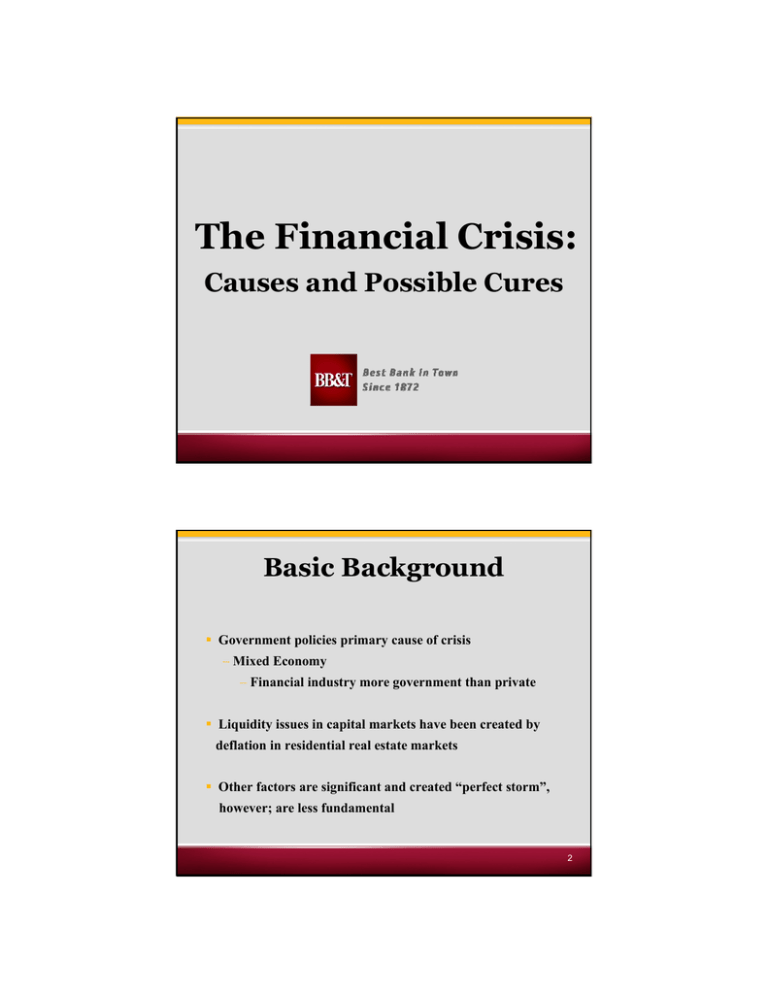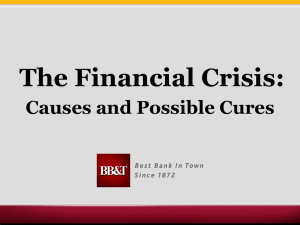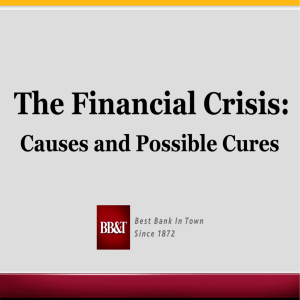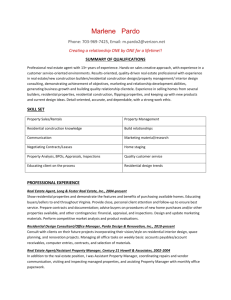The Financial Crisis: Causes and Possible Cures Basic Background
advertisement

The Financial Crisis: Causes and Possible Cures Basic Background Government policies primary cause of crisis – Mixed Economy – Financial industry more government than private Liquidity issues in capital markets have been created by deflation in residential real estate markets Other factors are significant and created “perfect storm”, however; are less fundamental 2 Residential Real Estate $600+ billion overinvestment in residential real estate Too many houses, houses too big, houses in wrong place. Should have invested in technology, manufacturing capacity, agriculture, education, etc. 3 How Did Overinvestment of this Scale Occur Only government can make a mistake of this magnitude possible Primary Sources of Problems ― Federal Reserve ― FDIC ― Housing Policy ― Freddie Mac / Fannie Mae ― SEC 4 Government Policy As Causation Federal Reserve Government owns monetary system – Unlimited federal debt / print money / inflation – Reduced capital requirements – Perception of “no” risk • Low savings rate – Significant mismanagement of monetary policy – Inverted yield curve Problems with Federal Reserve are systems design: many outstanding people at Fed. 5 Government Policy As Causation FDIC Insurance Lack of market discipline Start-up banks: Atlanta Indy Mac, WaMu, Countrywide: as examples 6 Government Policy As Causation Housing Policy Increase home ownership above natural market rate Tax policy Affordable Housing / Subprime: NY Times 9/30/99 Freddie Mac / Fannie Mae: Government sponsored enterprises – Would not exist in free market – Leverage 1000 to 1 – $5 Trillion – Government did have to “bailout” – implied guarantee – Politics Freddie / Fannie primary current cause of housing/financial problems Belief that housing prices never fall: based on government policies 7 Fundamental Role of Financial Intermediaries (Banks) Liquidity Issue Enable individuals to invest for longer periods than savers want to have their money invested: Pool Risk – credit and liquidity Borrow short / lend long: significant role in creating economic growth When they cannot sell assets financial institutions cannot meet liquidity requirements Bear Stearns: solvent but not liquid – Not happened in many years 8 Fundamental Role of Financial Intermediaries Leverage Banks are leveraged 10 to 1 Investment banks leveraged 30 to 1 Federal Reserve has “encouraged” increased leverage to fund government debt SEC established capital rules for investment banks using mathematical models Pre-Fed banks leveraged 1 to 1 Even conservative banks had to leverage to be competitive 9 How Did Residential Real Estate Markets Create Financial Crisis Ultimately residential real estate values are driven by the cost of reproduction, affordability and the cost to rent. From their peak, residential real estate prices need to fall 30% to become affordable. (All numbers are roughly approximate and national in scope – markets vary materially) 10 Bad News Residential real estate values have fallen 20% (U.S.) The fall has destroyed $500+ billion in capital in financial services industry Financial intermediaries leveraged 10 to 1 – Investment banks 30 to 1 $500 billion x 10 = $5 trillion in liquidity lost Some capital replaced = actual loss of liquidity “guesstimate” $3.0 trillion 11 Bad News Fear of additional decline in real estate values of $100 billion or more Destroy $1 trillion or more in liquidity No more capital for financial intermediaries because of unknown “bottom” in real estate – may go past affordability: ― WaMu debt holders “wiped out” Housing overbuilt in other countries and foreign banks heavily invested in U.S. housing – international liquidity problem 12 Role of State Foreclosure Laws Why Have Residential Real Estate Markets Not Cleared? Why have residential real estate prices not already fallen 30% and market correction passed? Agriculture markets always clear Bankruptcy / foreclosure laws: dramatically slow clearing process 13 Example: You make $190,000 loan to Jerry and family to purchase $200,000 house in Florida: House prices always appreciate Jerry becomes an alcoholic: loses job Price of Jerry’s (your) house declines 20% Jerry has nothing to lose: you have $180,000 to lose Jerry takes bankruptcy in Florida: 2 year free rent – remains alcoholic – no motivation to solve problem The hardworking honest Thompsons would be glad to rent house. Must remain in mobile home at hurricane risk Real stories: visit any mortgage collection center 90 day moratorium on foreclosures will lower all real estate values 14 Another Failure of Government Policy: How Did Residential Real Estate Markets So Significantly Impact Capital Markets Subprime mortgage crisis Failure of rating agencies: S&P / Moody's / Fitch: Government sanctioned (SEC) Market could not evaluate risk: no liquidity Auction Rate Municipal Bond Market Ambac, MBIC – Insurance / mortgage and municipal S&P, Moody’s, Fitch rating of AMBAC, MBIC – not reliable Lack of liquidity / bonds not marketable at almost any price BB&T has plenty of money to lend 15 Another Failure of Government Policy: Fair Value Accounting New accounting rule: mark-to-market Does not work when there is no market: ― Inconsistent with law of supply and demand: must be willing buyer and willing seller ― Violates “going concern” concept Major Cause of systematic liquidity problem: Public companies not purchasing economically valuable assets because of accounting risk Fails to consider gains. Example: bank retail deposits 16 Fair Value Accounting Asset values should be based on projected cash flows, not “fire sale” value If Fair Value Accounting applied in 1990 U.S. financial system / economy would have failed If applied to all business in U.S. as applied to financial intermediaries: 90% of U.S. businesses would be insolvent given lack of liquidity in markets SEC (government agency) makes accounting rules: i.e., laws: primary supporters of Fair Value: State Government and union pension plans 17 FDIC Insurance Makes “Pick-A-Payment” Mortgages Possible Owe $1,000 interest per month; only pay $500 – Each month you owe more on your house Targeted at high growth markets: CA, FL, etc Golden West (Wachovia) / WaMu / Countrywide – Only possible with FDIC Insurance Why BB&T did not offer product – Mission – “Trader Principle” 18 How Government Policy Created “Originate and Sell” Model Federal Reserve / FSLIC systematically destroyed thrift industry “Originate and sell model” replaces “originate and hold” Freddie/Fannie drive many financial intermediaries out of mortgage markets due to government guarantees on debt: leverage 1000 to 1 – lower cost of capital – Encourages banks to hold riskier mortgages Freddie/Fannie make “mortgage broker” origination model viable – Brokers feed Countrywide/Washington Mutual who feed Freddie/Fannie to meet “affordable housing” goals to keep support in congress 19 Originate and Sell Perverse incentives for originations: sloppiness/fraud S&P, Moody’s, Fitch (government sanctioned) make huge rating mistakes Investment bankers create financial “innovations” under belief that Federal Reserve will keep risk in financial markets low Investment bankers make irresponsible decisions based on pragmatic thinking: i.e., short term: irrational/lacks integrity/evasion/arrogance 20 Another Factor: Misuse of Credit Instruments CDO / SIV / CDO2 (Double Leverage) – Failure of rating agencies (S&P, Moody’s & Fitch): Government sanctioned – Investment banks hold risky “strips” Credit Default Swaps (CDS) – AIG • Rating agencies • Failed mathematical models Investment banks “eat” each other: Bear Stearns? State government pension plans / public university endowments invest in hedge funds who speculate in CDS and short stocks Why Save AIG? – Insurance subsidiaries safe – To save Goldman? (crony capitalism or system risk?) 21 Misregulation: Not Deregulation Regulatory cost at all time high at peak of bubble (2005-2007) – Sarbanes Oxley – Patriot Act Irrational belief in “models” – Wachovia as “Best Practices” – BASEL/European banks Huge misdirection of management energy Bank Regulators pose major risk to residential construction and development industry – Talk one game / play another: unequal incentives for regulators 22 Failure of Government Policy SEC Sanctioning Rating Agencies BASEL rules for investment banks – Significantly increased leverage Misregulation – Sarbanes Oxley – Meaningless, confusing, detailed disclosure Short sale rules: not enforced Ownership of accounting system – Reliance on rules instead of principles – Fair Value – Loan loss reserves Artificially created fluctuations in accounting results 23 Why Markets Initially Perceived “Bailout” Programs Would Not Work HOPE Program creates perverse incentives with 20% “haircut” from appraised value which could drive real estate values lower: i.e., below affordable: Help few borrowers TARP #1 Program creates major issues: – How will mortgage bonds be priced? – Will government foreclose on houses or not? – Failure to foreclose will encourage many other homeowners not to pay mortgage: huge potential problem – If foreclose, where are resources to liquidate houses? 24 Why Markets Initially Perceived “Bailout” Programs Would Not Work Programs are totally focused on marginal borrowers – not fundamental residential housing deflation problem Banks are motivated to help borrowers that can be helped How many marginal borrowers are really victims? – Did not put anything down – Nothing to lose: remember Jerry – Bought bigger houses – Choose pick-a-payment: after offered fixed rate – Speculators: even if they live in house What about individuals who did not make unwise investments: my son vs. my other relative More rational to reward the prudent instead of imprudent: tax credit 25 Why Markets Initially Perceived “Bailout” Programs Would Not Work Moral risk is extremely important: Example from BB&T Mortgage Servicing There are no meaningful benefits to healthy financial institutions from HOPE and TARP #1 programs – in fact they create risk for healthy companies because they do not help residential real estate markets 26 Market Corrections Are Not All Bad World is a better place to live with Countrywide and WaMu out of business: misallocations of capital. Credit standards were far too loose at peak of bubble: standards need to be tightened – Excessive leverage Saving rate needs to be increased Overinvestment in housing needs to be corrected: less capital to housing: more to productive investment We needed a correction: natural market process: creative destruction We did not need a panic: never would have had excesses and misallocations of this magnitude without government policy – We would have experienced minor corrections all along 27 “Panics” Are All Bad Action of Federal Reserve, Treasury, President and Congress have created “panic” – $700 billion: scary amount – Inconsistency (Citi vs. Wachovia / Goldman vs. Lehman) – Unpredictability “Panics” negatively affect even the best run financial companies and the overall economy Even best run financial institutions had to compete against risky institutions Remember: Financial institutions borrow short and lend long: – “Panic” creates liquidity risk for all – Lending standards being too tight is destructive – Self fulfilling spiral down Deflation is extraordinarily destructive 28 TARP #2 Capital injection in banks: investment must be repaid with interest – Creates lending capacity – Increases willingness of banks to lend to each other FDIC Debt Guarantee FDIC insurance – $250,000 (TARP #1) – Unlimited non-interest deposits – Primarily helps small / weak banks FED Buys Rated Commercial Paper – “Saves” GE Did help liquidity problem: unknown is whether it will make people want to borrow 29 Effect of Government Financial “Rescue” Plan (TARP) All large banks have chosen to participate in TARP #2 because: – Intense regulatory “encouragement” – Failure to participate would be a major competitive disadvantage While positioned as providing capital to encourage healthy banks to lend, a significant purpose of TARP is to save weak financial institutions and, thereby, theoretically reduce system risk Long term effect: huge moral hazard – Reward excessive risk taking – A zebra does not change its stripes – Citigroup saved 3 times: each time bigger and worse 30 Effect of Government Financial “Rescue” Plan (TARP) Oligopoly created in financial industry: not by market forces, but by extremely arbitrary government actions (Lehman vs. Goldman) – 4 financial institutions “too big to fail” (maybe 9: why 9 first TARP) – Tremendous competitive advantage in funding long-term – Not selected by markets (Citigroup) – If “too big to fail” should be broken-up: anti-trust policy of Fed completely irrational Healthy financial institutions (BB&T) hurt by “bailout” – End of flight to quality – Continued irrational competition – Cost of FDIC insurance – Impractical not to participate: nature of government programs – Lost opportunities to make acquisitions – Message to take more risk in future? – Competing with “too big to fail” / government created oligopolies 31 What Are Possible Cures Immediate Real Estate Tax Credit Create a credible program that deals with deflation in residential real estate which is cause of problems in capital markets – 10% tax credit (true tax credit: available only to tax payers) – $150 billion – Will help all homeowners Nothing is as important as stabilizing residential real estate market Any program not focused on residential real estate will not be most effective way to solve problem 32 What Are Possible Cures Immediate Real Estate Tax Credit To become affordable, residential real estate prices (cost to purchase) needs to fall an additional 10% – Approximately $100-$150 billion. However, if prices fall $100-$150 billion financial institutions will leverage down (10 to 1) $1-$1.5 trillion – probably more because prices may fall below affordability due to capital constraints. 33 10% Real Estate Tax Credit 10% tax credit on residential real estate purchases Reduces cost to buyers without reducing price to sellers Available to all / also receive interest deduction Goal: to entice individuals to purchase real estate who would not otherwise invest at this time – Clear housing market Government sponsored once in a lifetime – “fire sale” 34 10% Real Estate Tax Credit Only available for new houses under construction (or completed) and pre-owned homes for sale as of January 1, 2009 Do not want to incentivize additional house construction Incentivize to act now – only available to August 30, 2009 – limited to $150 billion: first come / first serve (use part of $700 billion) Must have carry forward tax feature for everyone, and must be available to high income individuals – they pay taxes and have capital 35 Example: Jones’ incented to purchase retirement home in Florida: cost $225,000 instead of $250,000: – once in a lifetime deal Builder in Florida does not go broke Bank gets loan repaid / relends money Realtor, attorney, appraiser can pay their mortgages Jones’ not ready to retire: rent house “cheap” to Smiths’: who move out of mobile home Thomas’ family moves out of “broken down” shack where 5 families live to Smiths’ mobile home 36 10% Real Estate Tax Credit House prices stabilize Every home owner in America wins: – greater sense of security – willing to invest / spend Home equity lines have availability: More Retail Sales Capital markets can properly estimate losses / establish value for mortgage bonds Liquidity starts to return to markets 37 What Are Possible Cures Short Term Federal Reserve provides liquidity to financial intermediaries in core banking system only – Why save GMAC – irrational auto lender (7 year car loans) Federal Reserve buyback long-term Freddie / Fannie bonds to lower mortgage rates Cut business / corporate income tax rates – U.S. corporate tax rate is not globally competitive Cut individual income taxes: including high income individuals who pay taxes and have capital to invest Do not rescue any more non-banks – Let market correct Do not introduce any new programs – Markets can not deal with the unpredictable and arbitrary Do not waste resources on non-essential government programs (pork barrel) 38 What Are Possible Cures Long Term Deflation is potentially worse than inflation: However, risk of inflation after correction is extremely significant: Riskiest asset long term treasuries? Most fundamental issue is the attack on capitalism / free markets – We do not have a free market in U.S.: mixed economy – Financial system is primarily government owned: Federal Reserve – By far the primary causes of current financial crisis is government policy, not market failure: Federal Reserve, FDIC, Housing Policy, Freddie / Fannie, SEC, HUD Less regulation, not more 39 What Are Possible Cures Long Term Privatize / Liquidate Freddie/Fannie – After crisis: 2011 – Political risk / affordable housing Return to originate / hold for residential mortgages: Do not attempt to salvage originate / sell model: Canada – Reintermediate to banking system – Do not “save” irrational competitors: mutual money funds Federal Reserve stripped of powers: one basic goal to grow monetary supply at fixed rate (Milton Friedman – 3%) – Do not manage in short run Consider market based monetary standard (gold) – Federal Government owns monetary system: unlimited federal debt 40 What Are Possible Cures Long Term Raise capital requirements for bank (especially “start ups”) – Reduce FDIC insurance back to $100,000 Make it explicitly clear that Federal Reserve can not/will not “save” non-banks – If you buy GE’s commercial paper that is your risk Stop subsidies to housing (tax policy) Encourage productive investment – low/neutral tax rates: tax consumption, not savings – increase productivity Free trade 41 What Are Possible Cures Long Term Carefully and systematically privatize Medicare, Social Security, and education Significantly cut cost of defense: By defending U.S. – not “saving” world Encourage immigration of the productive and hardworking; especially well educated Restore discipline to system – Save more – Spend less 42 Deepest Causes are Philosophical Different Than You May Think Altruism – Affordable Housing – Redistribute from productive to non-productive – No one has a right to their own life Pragmatism – Short term: What works: Subprime worked for several years – Irrationality – Lack of integrity “Free Lunch” Mentality – Social Security – Medicare Lack of Personal Responsibility – Death of Democracies: Tyranny of Majority 43 Deepest Cure is Philosophical Life, Liberty, and the Pursuit of Happiness – Right to your life and your happiness – Personal responsibility – No “free” lunches Demands and rewards rationality / self-discipline Pursuit of each individual’s long term rational self-interest in the context of the “Trader Principle” – creating win/win relationships Atlas Shrugged (1957) 44 What Happens Now? Short Term We are in a serious recession: how deep and how long? – Real economic issues – Lack of confidence Global Financial Crisis will probably be contained: Fed / International Governments are not likely to make mistakes of 1930’s Most likely: modest economic recovery in 2010 45 What Happens In The Long Term Depends on us Continuation of Altruism / Free Lunch mentality will ultimately result in economic disaster: forces in motion to make disaster possible: Social Security deficit, Medicare deficits, government operating deficits, irrational foreign policy: demographics: failed K-12 education system A return to individual rights, limited government, free markets which lead to personal responsibility and self-discipline can restore long term positive economic trends – We need less regulation, not more – Every time government makes big mistake the answer is more government American Sense of Life: Good News! Principled individuals / principled leadership 46 BB&T 47






